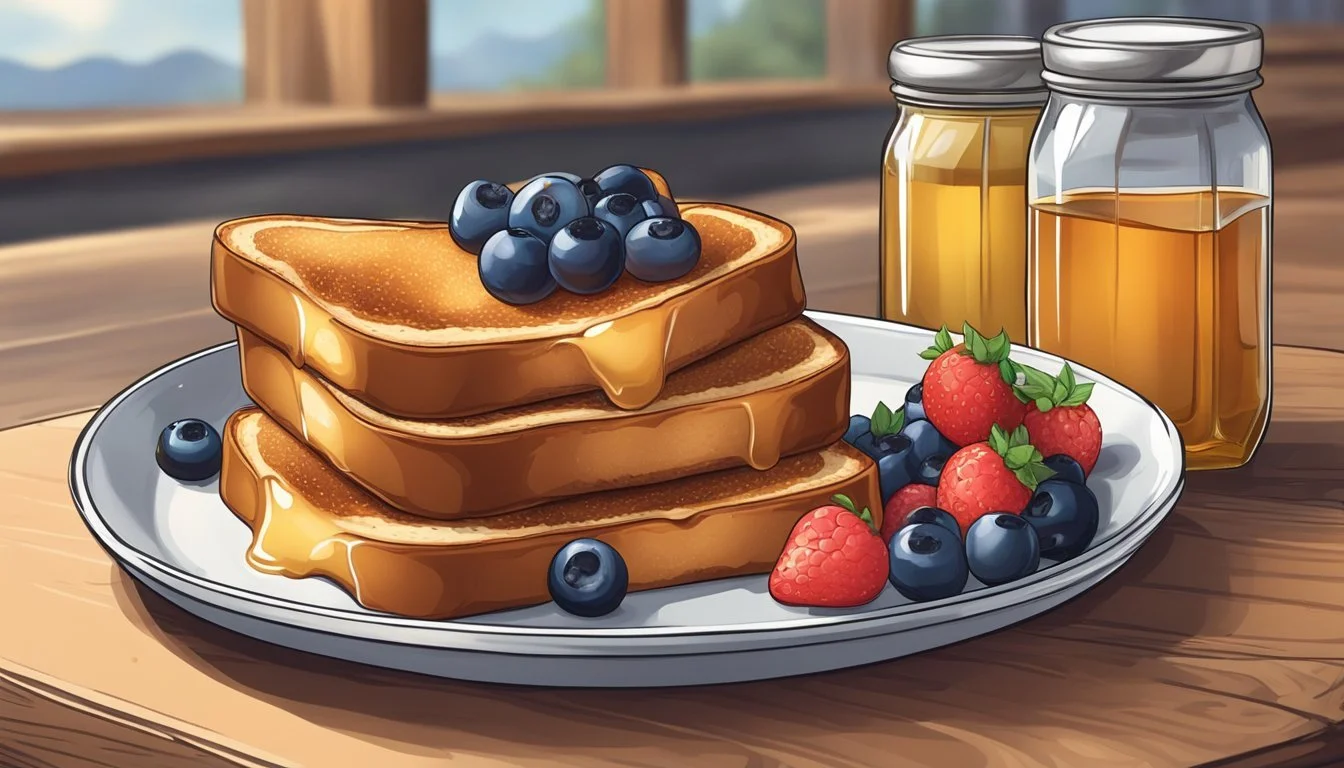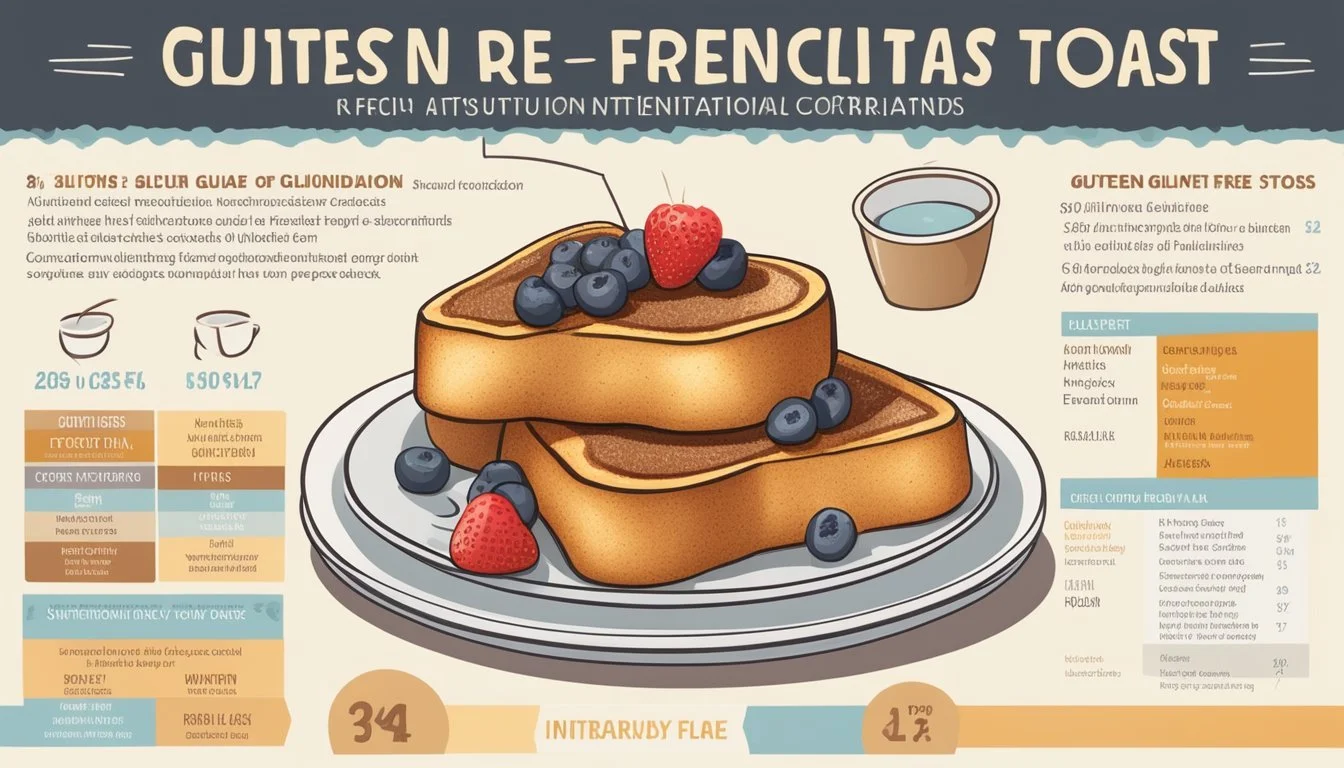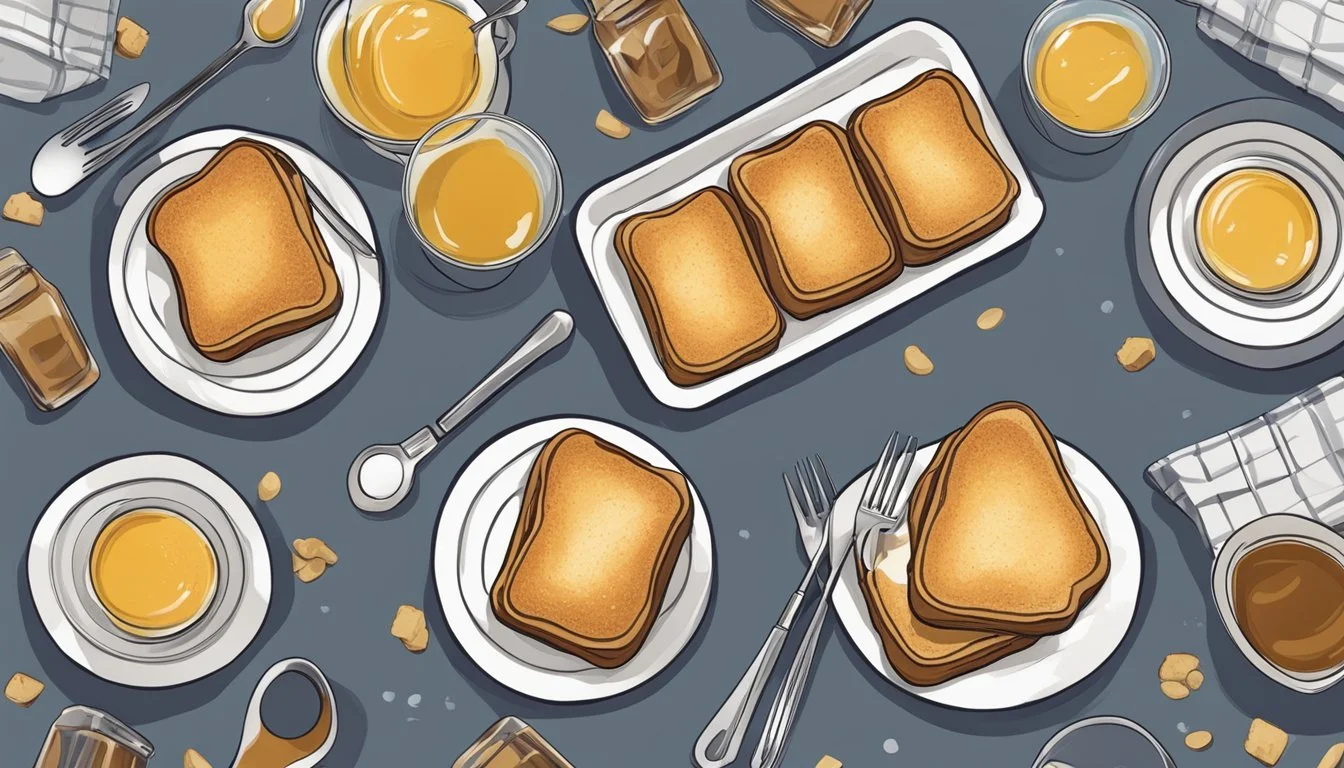Is French Toast Gluten-Free?
Understanding Its Ingredients
French toast is a beloved breakfast dish traditionally made by soaking slices of bread in a mixture of eggs, milk, cinnamon, and vanilla before frying them to perfection. However, the classic recipe presents a challenge for individuals following a gluten-free diet due to the use of wheat-based bread, which contains gluten: a protein found in wheat, barley, and rye.
The good news is that the culinary world has adapted, and gluten-free French toast is now more accessible than ever before. By substituting conventional bread with gluten-free alternatives, those with celiac disease or gluten sensitivity can also enjoy this delicious breakfast staple without adverse health effects. Essential modifications include using gluten-free bread and ensuring that all additional ingredients, such as vanilla extract and toppings, are free from gluten contamination.
Understanding Gluten-Free Diets
To optimize health for individuals with celiac disease or gluten intolerance, the gluten-free diet emerges as a crucial nutritional plan. This section delves into the specifics of such a diet, from its definition, inherent benefits, to the various foods that conform to its guidelines.
Definition of Gluten-Free
A gluten-free diet strictly excludes gluten, a mixture of proteins found in wheat, barley, rye, and triticale. Its adoption is essential for individuals with celiac disease or gluten intolerance, as ingestion of gluten can lead to serious health implications for them. The Food and Drug Administration (FDA) mandates that foods labeled "gluten-free" must contain less than 20 parts per million (ppm) of gluten.
Benefits of Gluten-Free Eating
Individuals with celiac disease who adhere to a gluten-free diet often experience significant improvements in symptoms and an overall increase in quality of life. While the primary benefit is the prevention of the symptoms associated with gluten ingestion, the diet may also reduce the risk of long-term health complications such as certain cancers and infertility. However, it's paramount to understand that a gluten-free diet is not inherently healthier for those who do not have a gluten-related disorder.
Gluten-Free Foods
The cornerstone of a gluten-free diet is to consume foods that naturally lack gluten. These include:
Grains: Rice, quinoa, corn, tapioca, millet
Proteins: Meats, fish, eggs, legumes, nuts
Dairy: Most dairy products are gluten-free, but it's vital to check for additives that may contain gluten.
Fruits and Vegetables: All fresh fruits and vegetables are naturally gluten-free.
People following this diet must carefully read ingredient labels to avoid gluten, bearing in mind that processed foods might contain gluten as an additive. There is a rising availability of gluten-free substitutes for traditionally gluten-containing items such as bread, pasta, and cereal, which typically use alternative flours and grains.
Essential Ingredients for Gluten-Free French Toast
Creating delightful gluten-free French toast requires specific ingredients to ensure each bite is both safe for those with gluten sensitivities and delicious. The choice of bread and binding agents is paramount in this culinary pursuit.
Choosing the Right Bread
The cornerstone of French toast is undeniably the bread. One must opt for gluten-free bread that is also sturdy enough to withstand soaking and frying without falling apart. Bread varieties that are hearty, such as those made with a blend of gluten-free flours like rice, tapioca, and perhaps potato starch, tend to work well. Look for thick-sliced gluten-free breads as they are less likely to disintegrate during the cooking process.
Selecting Gluten-Free Binding Agents
Eggs are the traditional binding agent for French toast, providing structure and helping to create that classic custardy interior. For individuals seeking dairy-free options, nondairy milk can be used, such as almond, coconut, or soy milk. To cater to those who cannot consume eggs or prefer to avoid them, one might consider using an egg replacer made from gluten-free starches. Regardless of choice, these ingredients should be whisked until thoroughly combined.
Gluten-Free Bread: Must be hearty and thick-sliced for durability.
Eggs/Egg Replacer: Provides structure; select egg replacers if necessary.
Milk/Nondairy Milk: Adds moisture and richness; choose nondairy alternatives as needed.
Butter: Used for frying; can be substituted with oil for a dairy-free version.
Perfecting the Gluten-Free French Toast Recipe
Crafting gluten-free French toast that rivals its traditional counterpart in flavor and texture begins with the right blend of ingredients and cooking techniques. Further, adding an array of toppings enhances the overall experience.
Creating the Custard Mixture
To start, one needs to prepare a custard mixture that both flavors and binds the gluten-free bread. The mixture typically contains eggs, a form of liquid like milk or a dairy-free alternative, pure vanilla extract, and seasoning such as cinnamon and salt. Some recipes suggest adding sugar, cinnamon, nutmeg, and even a pinch of salt to enhance the taste. To create the custard:
Combine 4 large eggs and 1 cup of milk in a shallow dish.
Stir in 2 teaspoons of pure vanilla extract and 1/2 teaspoon of ground cinnamon.
Add a dash of salt and whisk the ingredients together until thoroughly blended.
Cooking Techniques
For cooking the French toast, a nonstick skillet or frying pan is recommended. Melt a tablespoon of butter or warm a neutral oil over medium heat to prevent sticking and achieve a golden crust. Gluten-free bread tends to soak up the custard mix quickly, so a brief dip is sufficient to avoid sogginess:
Heat the pan to a medium temperature before adding the bread.
Soak each piece of gluten-free bread in the custard mixture for a few moments on each side.
Transfer the soaked bread to the hot pan and cook for 2-3 minutes on each side or until golden brown and set in the middle.
Topping and Serving Suggestions
Finally, toppings can turn simple French toast into a delightful meal. Traditional maple syrup is a must, but one can also consider fruit syrups, honey, or pancake toppings like whipped cream or fresh fruit slices. For those enjoying textures, cinnamon raisin bread can be used in the recipe or add raisins to the custard mix. Serving suggestions are as follows:
Drizzle with pure maple syrup or honey.
Sprinkle extra cinnamon or nutmeg on top for added spice.
Garnish with fresh fruit such as strawberries, blueberries, or banana slices.
Offer an assortment of toppings, allowing diners to customize their French toast.
Nutritional Information and Dietary Considerations
When considering the nutritional aspects of French toast, examining the calorie content and available allergy-friendly variations is crucial, especially for those with specific dietary restrictions.
Calorie Content
A typical serving of gluten-free French toast generally contains a similar calorie count to its traditional counterpart. However, the exact calorie content can vary based on the ingredients used. For a standard serving size, one might expect approximately 300 to 500 calories. Key nutritional components include:
Saturated Fat: The use of butter or oil contributes to the saturated fat content, which is around 2.2 grams per serving in certain gluten-free variations.
Cholesterol: Depending on the eggs and milk used, a serving of gluten-free French toast can contain around 104 milligrams of cholesterol.
Protein and Fiber: The protein content is derived from eggs and milk, while fiber depends on the type of gluten-free bread used.
Allergy-Friendly Variations
Gluten-free French toast caters to individuals with gluten intolerance or celiac disease with the use of gluten-free bread. Dairy-free and egg-free options can accommodate additional dietary needs:
Dairy-Free: Using alternatives like coconut milk or plant-based milks can make French toast dairy-free.
Vegan and Egg-Free: A vegan French toast utilizes substitutes for eggs, such as flaxseed or chia mixtures, alongside dairy-free milk.
Preparation and Cooking Tips
To ensure that French Toast is gluten-free and delicious, one must focus on proper preparation and cooking techniques. These steps are crucial in avoiding common pitfalls such as sogginess and achieving the desired texture.
Preventing Soggy French Toast
To avoid soggy French toast, they should use a thick-sliced, hearty variety of gluten-free bread. The bread should be dipped into the egg mixture just long enough to coat it, not so long that it becomes saturated. Cooking on a preheated skillet or griddle at medium heat ensures that the outside becomes crispy while the inside remains fluffy. Overcrowding the skillet should be avoided as it can cause steam to build up, which leads to sogginess.
Cooking Time Tip: Cooking each side for about 2-3 minutes usually results in a golden brown finish without sogginess.
Achieving the Perfect Texture
The texture of French Toast is paramount, it should be golden and crisp on the outside, tender but not wet on the inside. One achieves this by:
Preheating the skillet or electric griddle to the right temperature before adding the bread.
Using a mixture of eggs, milk (or a dairy-free alternative), and gluten-free spices.
Soaking the bread for just the right time—too short might leave it dry, too long can make it soggy.
Flipping the bread only once allows for an even cook on both sides.
Texture Control: An electric skillet or griddle offers more consistent heat control, which can help in achieving the perfect texture.
Cooking French toast in batches can also help; it makes sure that each piece is cooked evenly. If one needs to keep the toast warm while preparing more, they can place them on a wire rack in a low-temperature oven. This method prevents the toast from becoming soggy and retains its crispy texture.
Reheating: To reheat, they should avoid the microwave as it can make the toast soggy. Instead, briefly warm it up in a toaster or back in a skillet to preserve its texture.
Freezer Friendly: If made in large batches, French toast can be frozen. To reheat from frozen, they should toast it in an oven or toaster to maintain the quality and prevent sogginess.
Storage and Reheating Advice
Proper storage and reheating are essential for maintaining the quality and taste of French Toast. When handled correctly, French Toast can be a convenient make-ahead meal option.
How to Freeze and Store French Toast
To freeze French Toast:
Allow the French Toast to cool completely to avoid condensation.
Place a sheet of wax paper between each slice to prevent sticking.
Transfer the slices into a freezer-safe bag or container, removing as much air as possible.
Label the container with the current date; French Toast can be frozen for up to three months.
For storing leftovers:
French Toast should be stored in the refrigerator within two hours of cooking.
Place the slices in airtight containers or wrap them tightly with aluminum foil or plastic wrap.
Properly stored, they will last for 2 to 3 days in the refrigerator.
Best Methods for Reheating
To keep French Toast warm for serving, it can be placed on a baking sheet in an oven set at 200 degrees Fahrenheit until ready to serve. However, for reheating the stored or frozen French Toast, the following methods can be used:
Oven:
Preheat the oven to 350 degrees Fahrenheit.
Place the French Toast on a baking sheet and cover with foil to prevent drying out.
For refrigerated French Toast, reheat for 5-10 minutes. If from frozen, extend the time to 12-15 minutes, flipping halfway through.
Skillet:
Warm a skillet over medium heat and lightly butter it.
For a crispy exterior, reheat slices for 1-2 minutes per side until thoroughly warm.
Toaster or Toaster Oven:
For quick reheating, one can use a toaster or toaster oven.
Monitor closely to prevent burning, especially if the slices are thin.
Microwave:
It’s not recommended for the best texture but can be used for a quick warm-up.
Place the French Toast on a microwave-safe plate and cover with a damp paper towel.
Heat on medium power in 30-second intervals, checking for warmth.
By following these storage and reheating tips, French Toast can be enjoyed beyond the initial meal, making for easy and delicious serving suggestions for breakfast or brunch.
Creative Gluten-Free French Toast Variations
Perfecting a gluten-free French toast recipe opens the door to a myriad of flavor combinations and dietary accommodations. This section explores how to adapt the classic breakfast to suit vegan and dairy-free diets as well as how to enhance it with alternative toppings and fillings using gluten-free bread and ingredients that maintain the integrity of this beloved dish.
Vegan and Dairy-Free Options
For those seeking a vegan French toast, substitute eggs with a blend of tapioca starch and plant-based milk, such as oat milk or almond milk. For a richer taste akin to traditional French toast, you can use half and half made from coconut cream. Ensure the gluten-free bread is also vegan; some bread may contain honey or eggs. If the gluten-free bread is too fresh, allowing it to stale or lightly toasting it before soaking can improve texture. Baking French toast in the oven instead of on the stovetop can be a convenient alternative especially when serving multiple servings.
Vegan egg mixture:
Tapioca starch (for binding)
Oat milk or a mix of oat and almond milk
Optional: Add a pinch of salt and cinnamon for flavor
Alternative Toppings and Fillings
When it comes to toppings, think beyond maple syrup. Homemade compote from fresh or frozen fruits makes a delicious and healthier sweet topping. For fillings, layer the soaked bread with fruit preserves before cooking to create a surprise center. For added texture, sprinkle chopped nuts atop your gluten-free French toast and serve immediately to retain the crunch. To store leftover toppings, keep them in the freezer to extend their shelf life and maintain freshness, making them readily available for a quick gluten-free breakfast recipe.
Toppings and Fillings Suggestions:
Fruit compote: simmer berries with a touch of sugar or honey until thickened
Chopped nuts: almonds, pecans, or walnuts for added crunch
Dairy-free servings: oat milk whipped cream or coconut yogurt
Beyond French Toast: Gluten-Free Breakfast Ideas
Exploring gluten-free breakfast options expands the morning menu for those avoiding gluten. It ensures variety and maintains the delight of a satisfying first meal of the day, utilizing ingredients like gluten-free flour and fresh fruit.
Pancakes and Waffles
With gluten-free flour blends readily available, including rice flour or mixes from brands like Udi's, gluten-free pancakes and waffles are a delight. They can be easily whipped up using these flour substitutes. Followers of gluten-free diets can discover numerous breakfast recipes with a quick Instagram search, often featuring fluffy pancakes and crispy waffles that rival their gluten-containing counterparts.
Pancakes: One can create a batter using a combination of gluten-free flours or a pre-made gluten-free pancake mix. Add-ins like fresh fruit or a dash of vanilla heighten the flavor profile.
Waffles: For a crisper texture, one might opt for a waffle iron approach, where similar batter converts into golden-brown waffles.
Savory Breakfast Options
Savory dishes are as much a part of a hearty breakfast as sweet ones, and gluten-free options abound.
Bagels: Gluten-free bagels are available from multiple brands and can be topped with a variety of ingredients such as eggs, avocado, or smoked salmon.
Egg Dishes: Omelets and frittatas make for a protein-rich start to the day while naturally avoiding gluten. Incorporate vegetables, cheese, and meats for added flavor and nutrition.
AndFeel free to combine these with a side of easy French toast made with gluten-free bread, ensuring a breakfast that is both indulgent and within dietary needs.
Conclusion
French toast, by tradition, is not gluten-free due to the wheat bread used. However, one can certainly enjoy gluten-free French toast by substituting regular bread with gluten-free alternatives. Homemade gluten-free bread or store-bought varieties offer a safe choice for those with gluten sensitivities or celiac disease.
When preparing gluten-free French toast, attention to the nutrition information is advisable. Gluten-free breads can vary in their content of total fat and carbohydrates. Some may even contain additional ingredients to enhance texture and flavor, potentially affecting the overall nutritional profile.
For a balanced dish, one can refer to recipe notes and suggestions for incorporating nutritious toppings and sides. Fresh fruit, natural sweeteners like honey and maple syrup, or even savory options such as bacon or cheese can enrich the dish without compromising the gluten-free integrity.
In summary, with the right bread and slight recipe modifications, gluten-free French toast becomes a delightful and inclusive meal option, meeting the dietary needs and preferences of those avoiding gluten while providing the comfort and satisfaction of this classic dish.







